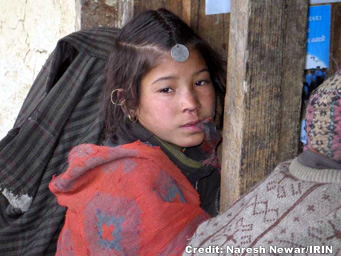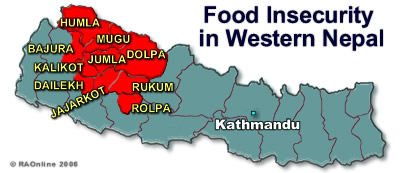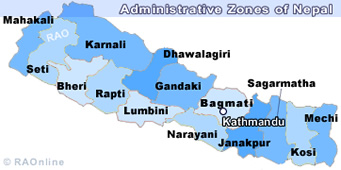|
Development
in Nepal: Reports on Food Crisis
|
 |
Nepal Development |
|
 |
Nepal Development |
|
|
 |
|
NEPAL:
2006 - WFP emergency food aid reaches drought-stricken villages
|
KATHMANDU,
2 Aug 2006 (IRIN)
Drought-stricken
villages in northwestern Nepal have begun receiving grain from the United
Nations World Food Programme (WFP).
The
US $5.3 million operation, considered by WFP to be one of its most difficult
and expensive, started in July in response to the severe shortage of food
faced by villagers in Bajura, Jajarkot, Kalikot, Dailekh, Rolpa, Rukum,
Jumla, Humla, Dolpa and Mugu districts.
 |
| Villagers in the drought-stricken districts of remote mountain regions
have been suffering from acute food shortage.
The
districts have a history of food shortages due to their high altitude locations.
The Action Contre la Faim (ACF), a French international NGO, said that
steep slopes, poor soil and dry climate limited cultivation.
Nepalese
experts said a severe winter drought, the worst of its kind in 40 years,
had made the situation much worse.
For
WFP the major challenge has been transporting food to the districts because
most of the roads are not navigable. |
|
The food has to be airlifted or carried
by porters, tractors or mules, lifting the cost to as much as US $350 per
mt.
Richard
Ragan, WFP Nepal's representative, said many of the districts could only
be accessed by helicopter. The start of the monsoon had made using roads
nearly impossible, with trucks blocked by landslides and rising rivers.
top
 |
| WFP's
partners, Support Activities for Poor Producers of Nepal and the Development
Project Service Centre, were helping to find alternative transport including
tractors, mules and porters.
"In
some instances, villagers have had to walk for up to five days to collect
their [food] rations," Ragan said. |
|
WFP
had also sought help from the Nepalese Army. It had been using three commercial
MI-17 helicopters to carry four mt of food per flight.
By
30 July, some 188 mt had been airlifted to Bajura, with 1,300 mt more to
be airlifted to Humla, Jumla, Dolpa and Mugu districts, according to WFP.
An additional 1,100 mt was delivered by truck to Bajura, Jajarkot, Kalikot
and Dailekh.
WFP's
aim was to feed a quarter of a million villagers. However, there were concerns
that it may not be able to give more aid to six out of the 10 districts
if additional funding was not pledged.
"We
know this is an area that has chronic food shortages but several years
far below average production have pushed people over the edge," Ragan said.
Source:IRIN 2006
Copyright
© UN Office for the Coordination of Humanitarian Affairs 2006
[
This report does not necessarily reflect the views of the United Nations] |
 |
Integrated
Regional Information Networks (IRIN), part of the UN Office for the Coordination
of Humanitarian Affairs (OCHA)
top
|
NEPAL:
2006 - WFP starts emergency food deliveries to Nepal
|
Kathmandu,
23 June 2006 - WFP
WFP
has started transporting emergency food assistance to help communities
in western Nepal hit by drought in an operation that is eventually expected
to reach 225,000 people.
 |
| Queueing for government food - many parts of Nepal do not grow enough to
feed the population Richard
Ragan, WFP County Director in Nepal
Nepal
has had its driest winter since 1960, according to government records,
and last year's monsoon rains were late and erratic ? this on top of two
poor harvests in a region that is already chronically food insecure.
|
|
"Food
insecurity is already a fact of life in these districts, and we are very
concerned that drought will exacerbate what was already a precarious situation,"
said Richard Ragan, WFP County Director in Nepal.
Remote
"To
further complicate things, many of the target areas are located in some
of Nepal's most remote locations and could require very expensive airlift
operations. With the rains approaching, the time to act is now if we are
to be able to save lives in these areas."
Assistance
will be provided through an accelerated Food-for-Work programme.
Families
in drought-hit areas will receive a two-month ration of rice and fortified
wheat flour as they participate in quick-impact community projects.
The
three-month emergency operation is intended to tide families over to the
next harvest, and will cover nine districts in the mid-west area of Nepal,
along with Bajura district in the far west.
Struggle
"While
there has been much attention on the easing of the recent political crisis
in Nepal, these developments have had little impact on people in the drought-affected
districts," said Ragan.
 |
| "Families
are struggling to find enough food to feed their children by selling their
household goods and livestock to survive the rainless period."
Because
many of the drought-affected communities are some of Nepal's most isolated,
WFP will launch an appeal to support airlifts into the most inaccessible
areas. |
|
| Source:WFP
2006 |
 |
| more information |
 |
| Links |
 |
 |
 |
External
link |
|







